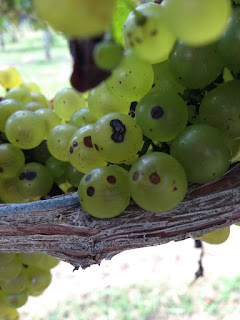It looks like our Chardonnay buds are swelling, which probably means that growers in the south and central Virginia either start to see bud break. Then the forecast is calling for rains next week. I guess it is a typical Virginia spring.
One of the diseases you need to consider soon after bud break is Phomopsis cane and leaf spot. It causes minor leaf spots, which are more evident to our eyes, but necrotic lesions cause more critical damage on shoots and rachis. It also causes berry rot; however, it is not common with wine grapes because of our spray programs. Some cultivars, such as Viognier, Cabernet Sauvignon, and Seyval Blanc, are more susceptible to Phomopsis than the others.
Phomopsis spores can cause infection requires water, and Phomopsis spores can germinate in a relatively cooler environment (the upper 40s). This pathogen tends to produce spores in spring from previously infected canes and cordons. Thus, springtime rain events are ideal for the development of Phomopsis. It is vital to protect young tissues when they come out from the older canes and trunks because we do not have any curative fungicides against Phomopsis.
This disease typically takes a while to establish in the vineyard. It may take 4-5 years for Phomopsis to become noticeable after you start a new vineyard. However, once established in a vineyard, it is difficult to get rid of this disease. The fungus survives in canes and trunks that were infected in previous years, and it can cause damages to cordons and trunks. In other words, this disease can cause long-term damage to cordons and trunks.
If rain events are coming into the picture after bud break, mancozeb (FRAC = M3, Penncozeb, Dithane, Manzate, etc.), Ziram (FRAC = M3), and captan (FRAC = M4) are useful protective materials against Phomopsis. Since shoots will proliferate quickly, you may need to spray several times against Phomopsis, depending on how much rain we receive. One or two applications, starting from 1 to 2 inches shoot length and repeated seven to ten days apart, is sufficient in a typical year. After that period, your downy mildew or black rot applications, which happens in the late spring, most likely cover Phomopsis.
QoI (FRAC = 11), such as Abound and Pristine, as well as SDHI (FRAC = 7), such as Luna Experience, Miravis Prime, Aprovia, and Aprovia Top are effective too. However, you probably don't want to use them this early in the season because you will need these materials for the latter part of the season to control other diseases (e.g., ripe rot and bitter rot).
The other disease that you may need to consider around this time of the year is anthracnose, which is more common with a certain hybrid species. Typical symptoms are black necrotic lesions on leaves, shoots, and fruits, and often, the black lesion has an ash-colored center, as if you burnt the leaf or shoot tissue with a cigarette. The management strategies will be similar to that of Phomopsis, and in addition to the list above, Topsin-M (FRAC = 1) is also known to be effective.



Comments
Post a Comment
Please leave your comment here. In order to avoid spam messages, l moderate comments, thus it may take a few hours for your comment to be posted on the page.